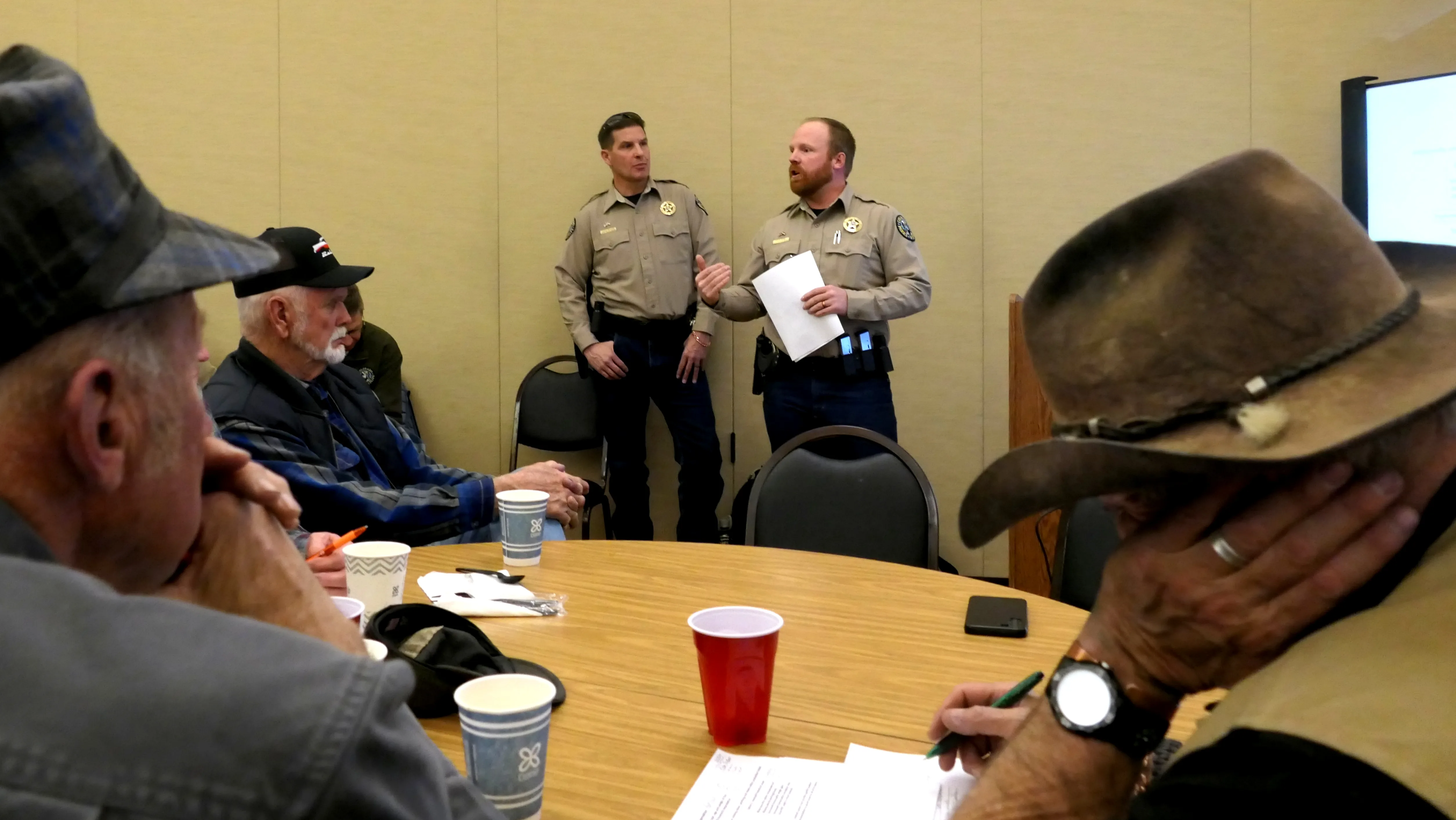
By Shannon Lukens. (This story has been updated to include results on the Senate Hearing vote on Thursday regarding the three nominees to the CPW Commission.)
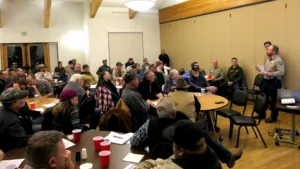
Colorado Parks and Wildlife officials met with local ranchers from throughout Northwest Colorado for a discussion on wolves Wednesday night. The meeting was at the Steamboat Springs Community Center.
This report has two parts. The first part is about the meeting with CPW officials and ranchers on Wednesday.
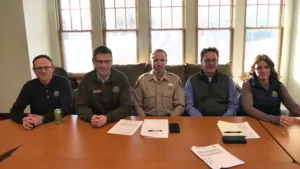
The second part is about an interview with Steamboat Radio News. News Director Shannon Lukens asked questions of (from left to right):
- CPW Public Information Officer on Statewide Topics Travis Duncan
- CPW Species Conservation Program Manager Parks and Wildlife Commission Eric Odell
- CPW Area Wildlife Manager for the Northwest Region Kris Middledorf
- CPW Director Jeff Davis
- CPW Public Information Officer Northwest Region Rachael Gonzales
Their comments and soundbites are below.
Meeting – Wolves are Here: What’s Next?
At the meeting, Area Wildlife Manager Kris Middledorf answered many of the rancher’s questions on what to do if a wolf injures or kills their livestock, and how they can help prevent that from happening.
“It was a really good meeting tonight, Shannon. All of our community, our livestock producers coming here tonight to talk about wolf restoration and talk about how we can minimize conflict, but really, we’re going to have to do it together and I appreciate our community for being here tonight with us.”
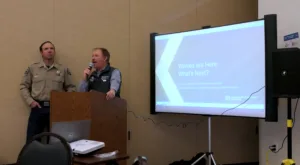
The meeting was organized by the Routt County 4H Extension office. Director Todd Hagenbuch told the crowd that they have been put in a contentious situation so he wanted the meeting to provide education. He said, “We’re resilient people, we always have been. When we are dealt a tough hand, we are going to figure out how to get through it.”
WOLF DEPREDATION INCIDENTS
Regarding reporting a wolf depredation incident, the ranchers were told to preserve any evidence, take pictures, cover the tracks with something so they aren’t covered with more snow.
Contact CPW immediately if there is a suspected wolf kill. Let CPW come out for the necropsy and let them skin the animal to check for bite marks as predators kill differently. They are trained to tell if it is a wolf kill.
Veterinary expenses are limited to $15,000 for reimbursement. The maximum per animal for reimbursement is $15,000. They can compensate for decreased weight and/or conception weight.
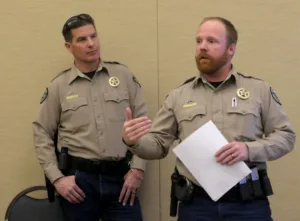
CPW Officer Kyle Bond says they are, “paying for the value of a bred cow vs. an unbred cow.” He also says if they think it is 50.1% chance of it being a wolf kill, they will confirm it as a wolf kill.
Officer Bond says this is an evolving process. They want to hear from the ranchers and hear how to compensate them fairly. They discussed the turnaround time on compensation. Turn in paperwork within 90 days. They’ll sign off on approval and payment should happen within 30 days. Or you can file an itemized claim on Dec. 31.
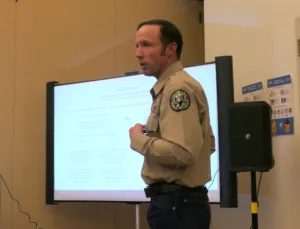
Officer Middledorf said, “We will work with you through the entire process to file that claim.”
They spoke of the officer training and how they can identify wolf as predation. It could be a canine. Officer Middledorf said the three officers in the North Park area are the best in Colorado in confirming a wolf kill. They use Bite Methodology.
Middledorf said the CPW Conflict Specialist is Adam Baca. They are hiring four more conflict specialists in the next six months. This is for bears, wolves, and lions.
CONFLICT MINIMIZATION
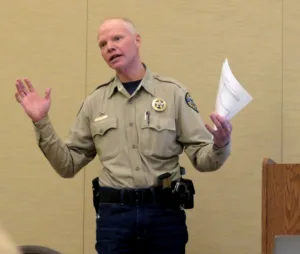
CPW Wildlife Officer and the 2016 Wildlife Officer of the Year, Josh Dilley, spoke of Conflict Minimization. “We understand that nobody knows how to run your operation better than you do. You are the producers and you are doing an excellent job.”

He spoke of Fladry. They only have electrified fladry. They also have scare devices, including fox lights, propane cannons, and shell crackers.
There is a two-page form/contract to request Conflict Minimization and Materials, and there is a Site Assessment form.
Materials are loaned on a case-by-case basis, and are temporary. There is a limited supply. What you receive depends on:
- Proximity of wolves to livestock
- Previous confirmed wolf damage
- Time of year
- Pasture size and location
Officer Dilley said, “Wolves are a predator, and they eat every day.”
Rancher Dave Gittleson (Don’s son from Jackson County) was at the meeting. He was asked what has worked on their ranch, which has had at least seven depredation incidents from the wolves in North Park. Gittleson said the fladry is very difficult to manage on a daily basis. The fox lights did nothing. “The first night we put them out, the wolves came in.” He added, “Even with people out driving around in the wolves, it didn’t work.”
Conflict Minimization Techniques for Consideration are:
- Livestock Guard Dogs – Wildlife services has a program that provides dogs to producers.
- Range Riders/Herders
- Management Intensive Grazing
- Herd Composition – This includes adding some burros, or possibly horned cows. Bring a breed with stronger motherly instincts to protect their calves.
- Carcass Management
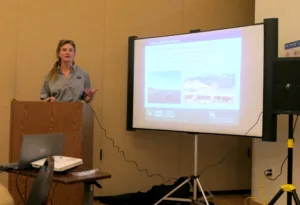
Lauren E. Emerick is a Non-Lethal Wildlife Specialist with the U.S. Department of Agriculture. Her job is to help producers protect their livestock from predators. She added that non-lethal tools are constantly evolving.
Emerick said fladry is flags on a string, sometimes electrified, and the wolves are confused. She said maintenance is intensive but it can be effective for up to 90 says in deterring a predator. The fladry can be run off of a solar panel or battery, with from six to 10,000 volts. The older it gets, the less effective it is. Wolves go up to smell the flags and their nose touches the electrified wire which is what scares them away. She said fladry maintenance in the winter is difficult.
Emerick said they have many trail cameras to provide to producers. “Boxes of them.”
LIVESTOCK PROTECTION DOGS
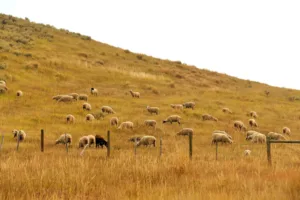
(The Livestock Dog is front row, lower right.)
Emerick spoke about Livestock Protection Dogs that are available. They are specially bred and raised dogs to watch your livestock. The presence of the dogs can deter predators. They are given to producers as puppies, and they are vaccinated.
The two breeds that they have found work best are Turkish Kangal and Bulgarian Karakachan.
Emerick said one study has shown that Turkish Kangals are 95% effective.
The way it works is that a producer receives two 10-week-old puppies for free. The first year of medical costs is paid for. The puppy is in a pen with a calf for at least four months, where they bond and the dog knows to protect the calf, and then the other calves. The guard dogs work best in pairs.
Nineteen dogs have been placed since 2020, and 14 dogs are still on the landscape in six counties with seven cooperators.
To avoid having dogs picked up by strangers, some ranchers have put up signs that say, “Working dogs in the area.” Others have tags on collars that say, “This is a working dog. Don’t pick up.”
HAZING
Hazing was discussed if there are wolves on your property. Please immediately call CPW and fill out the Wolf Sighting Form.
You can do anything to scare off a wolf, such as make noise and chase it. But let CPW know.
Injurious, non-lethal hazing tools include rubber buck shot and bean bags are available. Fill out an application with CPW to make sure you meet the criteria and you will get a permit. Game Damage
RETROACTIVE PERMIT
There is also a “Retroactive Permit.” This is for, “in the act of.” If you see a wolf chasing, biting, attacking or wounding your livestock or working/guardian dogs, you can kill it. But only if you see it happening. Then you call CPW right away and the “Retroactive Permit” will be issued. It says that you lawfully took that animal. This permit is very rarely issued, but it is available.
CHRONIC DEPREDATION PERMIT
You can also apply for a Chronic Depredation Permit. CPW has criteria, but it is not an objective definition. There has to be multiple, repeated incidents on your property. You will meet with CPW and USFW agents to confirm. The agents will do the removal of those animals that are involved in the chronic depredation. If they can’t, they will issue you the permit to do it.
Dave Gittleson asked about why North Park Wolf #2101 didn’t qualify since it has killed 17 animals, and it “went through our cattle once a week.”
Officer Middledorf said, “We will reassess that situation immediately if there is another incident.”
HUNTING
Ranchers asked if they can use artificial light to see where the wolf is to shoot it, if a wolf is attacking livestock. Artificial light isn’t legal for hunting. Middledorf said it is not lawful right now either, but they are looking into it.
He added, “We have learned more from the Gittleson family in the last four years. We will continue to discuss all of the options.”
Middledorf then said, “We will hold hands with our landowners and partners as this is a learning experience for all of us.”
He acknowledged that the elk are struggling. “If wolves have a major impact on the ungulate populations and there is a reduction in ungulates, we would have a reduction in hunting licenses.”
FROM THE RANCHERS
South Routt rancher Dean Rossi asked about Proposition 114 and asked if there is a specific set number of wolves that have to be released each year. There isn’t. But Middledorf said they plan to release ten to 15 wolves per year for three to five years. Locations have yet to be determined, but it will be 60 to 70 miles from a border.
Colorado Proposition 114, Gray Wolf Reintroduction Initiative (2020)
Dave Gittleson attended the meeting. He was disappointed to not hear from CPW Director Jeff Davis and Eric Odell.
“It was nice of them to come and show up but I would have liked to hear from both of them more and maybe have one of them stand up and speak a little bit about the topic.”
Another rancher said, as the meeting concluded, “We understand you are trying to help us, but there are some hard feelings.”
INTERVIEW WITH COLORADO PARKS AND WILDLIFE OFFICIALS

Steamboat Radio News was given ten minutes to ask questions of the following CPW officials:
- CPW Public Information Officer on Statewide Topics Travis Duncan
- CPW Species Conservation Program Manager Parks and Wildlife Commission Eric Odell
- CPW Area Wildlife Manager for the Northwest Region Kris Middledorf
- CPW Director Jeff Davis
- CPW Public Information Officer Northwest Region Rachael Gonzales
Here are the questions with the audio answers, also transcribed. There were fans on in the room so audio is somewhat muffled. No one could figure out how to turn the fans off.
Define Chronic Depredation and how a wolf qualifies for 10J. Director Davis answered.
“As you likely know, Senator Roberts and Speaker McCluskie sent me a letter basically requesting that I reverse my decision about the Gittleson Chronic Depredation situation but also asking us/CPW to create a definition for Chronic Depredation so we are in the process of looking at all the other states that have wolves and Chronic Depredation definitions and trying to figure out or formulate a draft definition that we would take to our commission for adoption.”
The last time you checked, how far are the two wolves in Moffat County from the Wyoming border?
Odell said they released the Wolf Tracking Map Thursday morning and proceeded to say it is available on the CPW website. (We had posted it on all Steamboat Radio/KRAI social media pages at least six hours before this meeting.)
CPW’s new Map Indicating Current Collared Wolf Activity in Colorado
Odell then said the wolves in Moffat County are in the same area that they have been for the last several days.
What happens if wolves cross into:
- Wyoming
- Utah
- New Mexico
- Arizona
Eric Odell answered, “When any species crosses state lines, there’s generally no action, no management action taken to try to retrieve those animals. There is no arrangement with Wyoming so if a wolf goes into Wyoming, there is no action we are going to take.”
“What about Utah, New Mexico, and Arizona?”
“We have an arrangement with those states because of the concern that has been expressed by the Fish and Wildlife Service in those other state agencies, and the investment that they have made to protect and conserve Mexican wolves. It’s a very different situation. So if a grey wolf from Colorado were to go south into Arizona, New Mexico, or potentially Utah, those animals could be retrieved and brought back to Colorado.”
Have you hazed the wolves with helicopters, keeping them from going somewhere? No.
Of the ten wolves from Oregon, did you test them for Hydatid Disease? (Tapeworm parasite) If Hydatid Disease is already here, where is it and how much.
Odell said, “We don’t have the results back.”
Steamboat Radio — “So you did test them but you don’t have the results?
Odell — “I believe that’s true. I don’t know for sure.”
Steamboat Radio — “And then you released them without getting the results?”
Odell said, “Yes.” He added that it is present throughout Colorado. “It is present in our native canine population so it is present in canine and foxes.”
From CSU Extension Office Wolves and Disease
- Hydatid disease is caused by the Echinococcus Canines such as wolves, coyotes, foxes, and domestic dogs are the definitive host, and ungulates such as deer, elk, moose, and domestic livestock are intermediate hosts. In rare circumstances humans may be infected by accidently ingesting eggs, but direct human infection from wolves is extremely unlikely.
- Dogs and wolves are closely related and also can share many of the same parasites and diseases. Dogs are much more likely to infect wolves than vice-versa.
Colorado Parks and Wildlife Hydatid Disease
Alaska Department of Fish and Game — A Field Guide TO COMMON WILDLIFE DISEASES AND PARASITES IN ALASKA — CYSTIC HYDATID DISEASE
At what point will wolves be considered self-sustaining recovered population?
Odell said, “We have recovery goals in our plan. When we meet 200 animals, we will downlist from a state threatened species to a non-game status.”
To Director Davis — How many times have you been to Jackson County? (not driving through).
Answer: Maybe twice.
Have you visited the Gittleson Ranch, and talked to Don?
Answer: I have not.
We introduced Dave Gittleson to Director Davis at the meeting.
“I think it would be good for both of them to see what’s going on, on the ground. I think they should be a little bit more involved with seeing what’s going on if they’re working on it, they should probably see how it’s going instead of sitting in their offices.”
How do you feel about the nominees to the CPW commission? (See results of Thursday’s Senate Hearing below.)
MEMBERS OF THE PARKS AND WILDLIFE COMMISSION for terms expiring July 1, 2027:
- Jess Beaulieu of Denver, Colorado, to serve as a representative of outdoor recreation and parks utilization, appointed;
- John (Jack) Murphy of Aurora, Colorado, to serve as a representative of outdoor recreation and parks utilization, appointed;
- Gary Skiba of Durango, Colorado, to serve as a representative of sportspersons and a member West of the Continental Divide, appointed.
Steamboat Radio — “I have a letter from Teller County saying this is not a good appointment.”
Davis said, “I would say my experience to date with the three appointments, these are good people. They’ve done a ton of work to get caught up to speed on what CPW does, had lots of meetings with stakeholders. And quite frankly, I think our commission is a good commission in that they come from different perspectives and different experiences and they work together to come to compromise on our rules and regulations.”
They were asked if they knew of any other letters or commissioners or officials opposed to the three appointments and they didn’t.
Today (Thursday, Feb. 29) Steamboat Radio News received a copy of a letter to Colorado senators titled, “Objections to the Appointments to the Colorado Parks and Wildlife Commission, dated, Feb. 25.” It is signed by 21 agriculture, hunting, and outfitter groups in the state, who are all in opposition to the nominees.



UPDATE Friday morning, March 1 — From Senator Dylan Roberts: Gary Skiba and Jess Beaulieu were not approved, 3-4. Jack Murphy was approved, 4-3. However, all nominees will move to the full Senate for final confirmation. They need at least 18 votes to be confirmed and stay as commissioners.
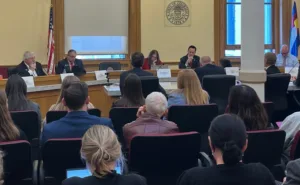
Courtesy photo from Senator Perry Will’s office
UPDATE Friday morning, March 1 — Senator Perry Will posted the following on his Facebook page:
From ColoradoPolitics.com — Colorado Senate panel rejects Gov. Jared Polis’ nominees to wildlife commission
Steamboat Radio News Past Coverage of wolves in Colorado
- Feb. 17, 2024 — TWO COLLARED WOLVES HAVE TRAVELED TO MOFFAT COUNTY
- Jan. 30, 2024 — CPW SENDS UPDATE ON WOLF SIGHTINGS SINCE 2004, AND MORE ON THE MAP
- Jan. 24, 2024 — ELECTED OFFICIALS GRILL DEPT. OF NATURAL RESOURCES AND CPW AT HEARING WEDNESDAY
- Jan. 22, 2024 — CPW GETS HARSH LETTER DEMANDING ANSWERS FROM ROBERTS AND MCCLUSKIE
- Jan. 19, 2024 — COLORADO’S NEXT WOLVES TO BE REINTRODUCED WILL BE FROM TRIBAL LANDS IN WASHINGTON
- Jan. 12, 2024 — CPW CONFIRMS WOLVES WERE IN SOUTH ROUTT BUT AREN’T (YET) IN MOFFAT
- Dec. 22, 2023 — FIVE MORE WOLVES ARE RELEASED BY COLORADO PARKS AND WILDLIFE
- Dec. 22, 2023 — CPW DENIES GITTLESON’S REQUEST TO IMPLEMENT 10(J) RULE ON JACKSON COUNTY WOLVES
- Dec. 21, 2023 — THREE OF THE FIVE WOLVES RELEASED IN COLORADO WERE IN PACKS THAT KILLED OR INJURED LIVESTOCK IN OREGON
- Dec. 19, 2023 — LIVESTOCK PRODUCERS RECEIVE WOLF UPDATE FROM CPW IN CRAIG MONDAY
- Dec. 13, 2023 — GITTLESON SAYS ANOTHER CALF WAS ATTACKED BY A WOLF TODAY
- Dec. 11, 2023 — COMPLAINT FILED IN U.S. DISTRICT COURT TO STOP WOLF REINTRODUCTION IN COLORADO
- Dec. 4, 2023 — KEEP YOUR PETS CLOSE AND CARRY A BIG STICK – CPW HAS ADVICE FOR LIVING WITH WOLVES
- Nov. 19, 2023 — THREE LAMBS KILLED BY A WOLF IN JACKSON COUNTY, SAYS RANCHER
- Nov. 17, 2023 – CPW AND CDA ANNOUNCE AGREEMENT TO WORK TOGETHER ON WOLF REINTRODUCTION
- Nov. 7, 2023 – U.S. FISH AND WILDLIFE SETS DATE FOR 10J RULE FOR WOLVES
- Oct. 6, 2023 – COLORADO WILL RECEIVE WOLVES FROM OREGON
- May 16, 2023 – POLIS VETOES 10J RULE WOLF BILL
- May 3, 2023 – CPW COMMISSION APPROVES FINAL WOLF RESTORATION AND MANAGEMENT PLAN
- May 2, 2023 – MANAGEMENT OF GRAY WOLVES REINTRODUCTION BILL PASSES IN STATE HOUSE
- May 2, 2023 –CPW MEETS THIS WEEK FOR FINAL WOLF MANAGEMENT PLAN
- April 27, 2023 – CPW CONFIRMS WOLF SIGHTING EAST OF KREMMLING
- April 8, 2023 – CPW WOLF COMMISSION MEETS IN STEAMBOAT SPRINGS
- April 3, 2023 – CPW TO PRESENT FINAL DRAFT WOLF RESTORATION AND MANAGEMENT PLAN IN STEAMBOAT SPRINGS
- March 28, 2023 – THE SOUTHERN UTE TRIBE ASKS THAT CPW RELEASES WOLVES ALONG I-70 CORRIDOR
- March 15, 2023 – TWO DOGS DIE FROM WOLVES IN JACKSON COUNTY THIS WEEK
- March 3, 2023 –COLORADO PARKS AND WILDLIFE COMMISSION RELEASES WOLF REINTRODUCTION MEETING RECAP
- Feb. 10, 2022 – MONTANA STOCKGROWERS VOICE SUPPORT FOR COLORADO RANCHERS OVER THE WOLVES
- Feb. 9, 2022 – WOLF MANAGEMENT DISCUSSED BY LOCAL RANCHERS AND OFFICIALS AT FORUM IN STEAMBOAT
- Jan. 22, 2022 – WOLF MITIGATION OPTIONS
- Jan. 19, 2022 – ANOTHER COW KILLED OVERNIGHT IN NORTH PARK BY WOLVES
- Jan. 18, 2022 – TWO MORE COWS ATTACKED BY WOLVES IN JACKSON COUNTY TUESDAY
- Jan. 12, 2022 – CPW ALLOWS WOLVES TO BE HAZED IN EMERGENCY DECLARATION
- Jan. 10, 2022 – A WOLF PACK KILL IS REPORTED IN JACKSON COUNTY OVER THE WEEKEND
- June 9, 2021 – WOLF DEN WITH PUPS CONFIRMED IN NW COLORADO